![]() By Amir Kamandlooie*, Scott Rouse** and Edward Newton***
By Amir Kamandlooie*, Scott Rouse** and Edward Newton***
This article describes Energy@Work’s experience in using EVO’s “Non-Routine Adjustment” (NRA) Method #6. Berkeley Castle is a mid-tier, historic, commercial office building in Toronto, Ontario. Our objective was to quantify the electricity savings resulting from energy efficiency measures and distinguish them from the kWh reductions due to lower occupancy during the pandemic from March 1st to May 31st, 2020.
We used Approach #5 for detecting a Non-Routine Event (NRE) and NRA Method #6 to quantify EE as outlined in EVO’s October 2020 “IPMVP Application Guide on Non-Routine Events and Adjustments”.
NRA’s Method #6 quantified the distinction between reduced building occupancy with existing electricity EEMs. The case study supports Method #6 as an effective, practical, transparent, and conservative method in quantifying electricity reductions and separating efficiency savings from pandemic-related impacts.
The NRCan RETScreen Software support team was provided the raw electricity data to validate the functionality of the software’s new NRA features. Method #6 was applied to the data set and yielded the same savings as Energy@Work’s calculations.
Introduction
Berkeley Castle is a family-owned-and-operated commercial office with mixed tenancy located in Toronto, Ontario, with a Gross Floor Area of 148,614 ft2. It was converted from a manufacturing facility with a historic designation to a commercial office.
Energy@Work Inc. was engaged in 2016 to help manage utility use and reduce costs. In 2017, Berkeley enrolled into a pay-for-performance incentive program focusing on low and no-cost operational improvements. The program required an Energy Management Action Plan (E-MAP) and Measurement and Verification (M&V) plan compliant with IPMVP guidelines. Verified electricity efficiency reductions are rewarded with an annual incentive of $0.025 /kWh. First and second-year annual electricity savings from 2017 to 2019 were verified and Berkeley received the incentive. In March 2020, the pandemic hit Toronto and commercial office occupancy was substantially reduced, including Berkeley Castle. This required a new method to quantify savings.
Application of EVO’s NRA Method #6
EVO’s 10 Methods for performing Non-Routine Adjustments (NRA) were reviewed and Method #6 was the most suitable to identify, quantify, and successfully verify the EE. Non-Routine Adjustments (NRA) are necessary to account for significant changes to an approved M&V model. The NRA consisted of a change in occupancy due to the COVID-19 pandemic. An approved method was needed to differentiate and quantify EE from electricity reductions because of lower occupancy. The method had to be consistent with EVO’s M&V guidelines to meet incentive requirements.
Measurement and Verification (M&V) Model
To meet the M&V pay-for-performance program requirements, a weather-dependent multi-regression model was developed using NRCan RETScreen Software. The baseline used the monthly unadjusted electricity data between January 2015 and December 2016. NASA’s weather database was used to download weather data into RETScreen for the utility review and approval. The data was weather-corrected, and an M&V model was constructed according to IPMVP guidelines.
The M&V model is based on 2 years of monthly electricity data taken directly from the utility meter and met IPMVP statistical indices. The model quantified savings, which were reviewed for an incentive of $0.025/kWh between 2017-19. Savings and operational changes were tracked during monthly E-MAP meetings between Berkeley Castle operations and management personnel and Energy@Work. The consistent communication allowed for close monitoring of NREs, changes in utility use, and operations, as well as prioritizing operational changes. Annual saving reports were submitted for review and were approved for the first 2 years of the program.
Tracking the Impact of the COVID-19 Pandemic
The third-year performance period started on June 1st, 2019 and ended May 31st, 2020. The monthly energy management meetings continued virtually through the COVID-19 period. Utility use was monitored and building staff provided monthly updates on changes in occupancy and operations. Occupancy was the principal change during the pandemic since a commercial office must remain open. There were no requests for additional hours of operation or other significant changes, such as the removal of a data center, disproportionate electricity change, or electricity metering configuration. First and second-year EE measures remained in place during the 3rd year.
EVO Detecting Non-Routine Event (NRE) Approach #5: Tracking Changes to Electricity Use through the ‘CUSUM’
Approach #5 was used to identify the start of the COVID-19 pandemic as an NRE. The CUSUM clearly shows the impact of lower occupancy on electricity use. The COVID-19 pandemic is shown in the small rectangle in the bottom right of Figure 1, extending from March 1st to May 31st, 2020. The first year had a verified and approved savings of 11%. The second year had verified and approved 23% savings. Savings in the third year were stable at approximately 30% from June 2019 to February 2020 but were interrupted in March, as seen in the change in slope, labeled NRE in the lower right-side rectangle box.
The avoided electricity consumption from March 1st to May 31st, 2020 is a combination of the EEMs and lower building occupancy and required an approved method to make the NRA. The first, second, and third year use the approved M&V model to quantify savings for the pay-for-performance period.
Figure 1. CUSUM Graph for First, Second, and Third Year of Pay-for-Performance Incentive Program
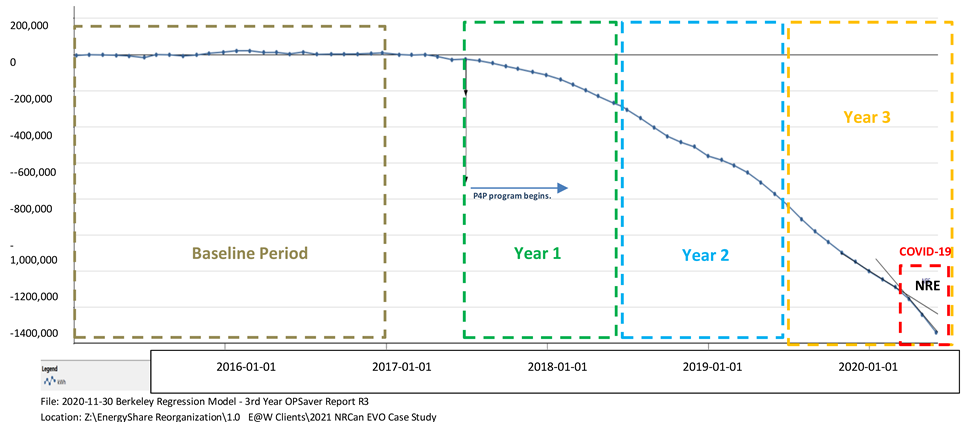
EVO’s Method #6, NRA Adjustment: Use of a ‘Mini’ Model
As prescribed by Method #6, a single regression ‘mini’ model using CDD was created based on the kWh bill data from June 1st, 2019 to February 29th, 2020. This quantified the impact of occupancy following the NRE. Table 1: ‘Mini’ Model Baseline Regression Information provides the detailed ‘mini’ model results.
Table 1: ‘Mini’ Model Baseline Regression Information
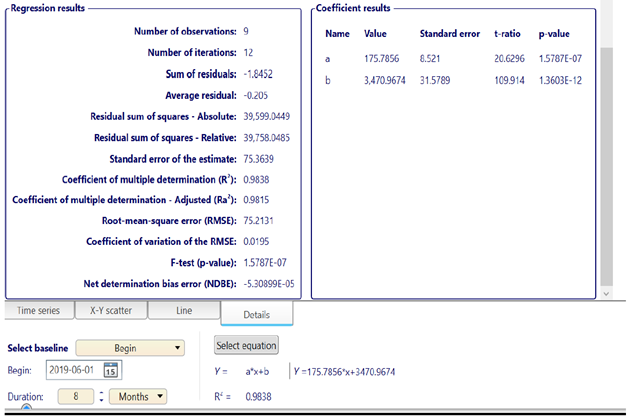
The ‘mini ‘model provides an excellent statistical result with an R2 of 0.98 and CV (RMSE) less than 2% (see Table 2: Statistical Values of the ‘Mini’ Model).
Table 2: Statistical Values of the ‘Mini’ Model
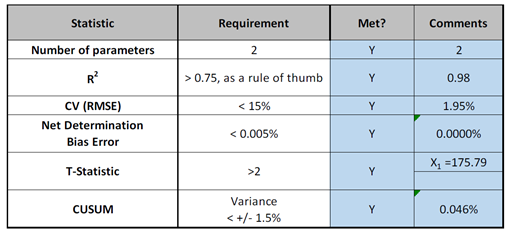
Method #6 does not specify statistical requirements; however, the same indices required by the pay-for-performance for the original baseline model were used to evaluate the ‘mini’ model.
Applying Method # 6’s ‘Mini’ Model Regression Results and CUSUM to Quantify Savings
The CUSUM in Figure 2. CUSUM Results of ‘Mini’ Model (March 1st, 2020 to May 31st, 2020) shows 84,542 kWh reduction due to lower occupancy during the pandemic.
Figure 2. CUSUM Results of ‘Mini’ Model (March 1st, 2020 to May 31st, 2020)
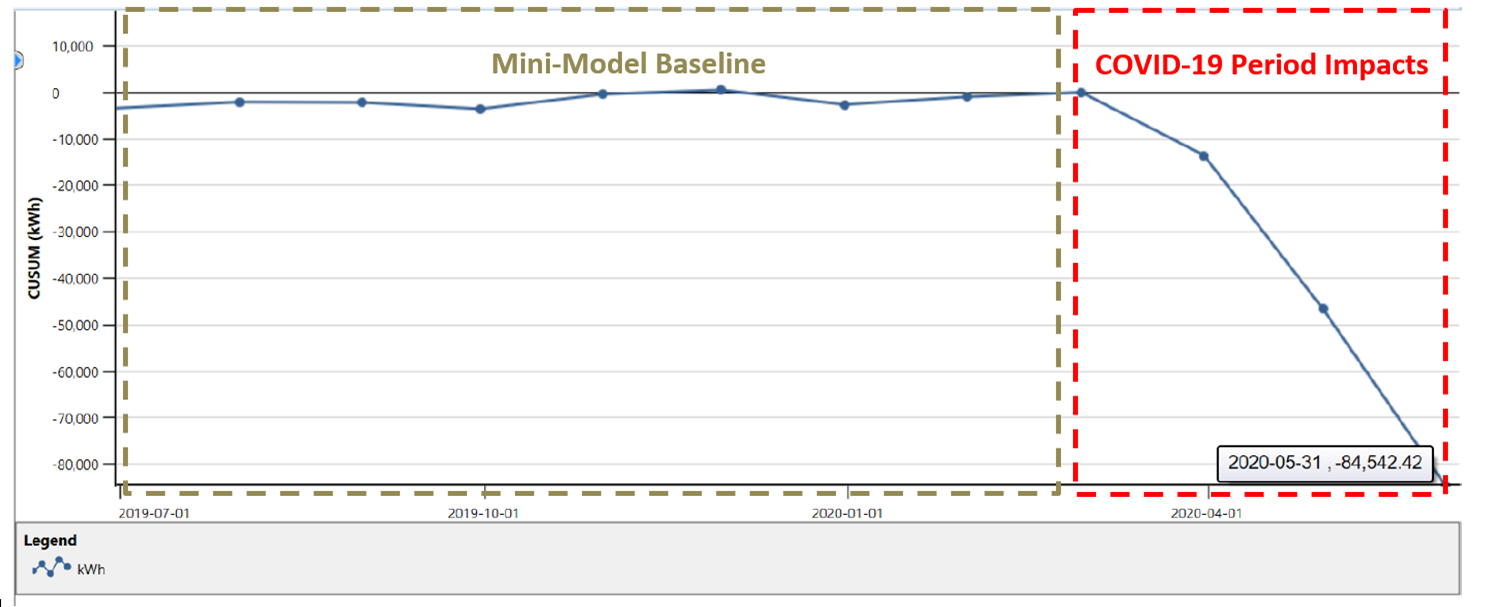
The NRA’s amount of electricity, 84,542 kWh, which was calculated from the ‘mini’ model was subtracted from the total avoided kWh (767,327 kWh) in the original model. This provided an adjusted 682,785 kWh savings for the period of June 1st, 2019 to May 31st, 2020. This savings is eligible for an incentive from the pay-for-performance incentive program of $0.025 /kWh. When factoring in the avoided cost of $0.17/kWh, the collective savings is $133,143 for the third year. The cumulative savings over three years exceeded 1,450,000 kWh with $275,000 in monetary benefit.
Table 3. Details of Pay-for-Performance Savings Results
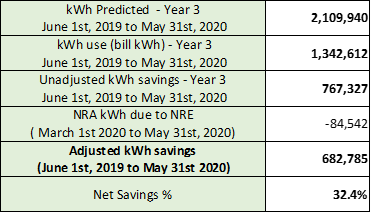
Separating Pandemic Electricity Impacts and Remaining Conservative
The NRE event occurred on March 15th, 2020, when the city-wide lockdown began, and Berkeley Castle’s occupancy dropped. However, the NRA was calculated to include the entire month of March to respect the principle of being conservative.
Conclusion
EVO’s commitment to supporting energy efficiency allowed Berkeley Castle to verify electrical savings during the first two years of the program by adhering to the IPMVP guidelines. The pandemic presented significant M&V challenges to verify electricity savings post March 1st, 2020 to May 31st, 2020.
EVO’s NRE Approach #5 and NRA Method #6 provided the support required to successfully verify the savings in our unprecedented pandemic situation. EVO’s commitment and support is highly appreciated and is a significant benefit to the M&V community for energy efficiency verification.
The raw electricity use was subsequently provided to the NRCan RETScreen support team, who are integrating Method #6 into a beta version of RETScreen. The output from the RETScreen model using Method #6 was compared with the case study findings and produced similar results. NRCan has plans to release the next version of RETScreen with a Method #6 feature.
Energy@Work continues to work with other buildings to confirm that similar results can be achieved once Method #6 is accepted by the pay-for-performance program and Berkeley Castle’s 3rd submission is approved.
Additional case studies are needed to validate other NRA Methods for different applications since every situation has its own unique circumstances.

Questions/Feedback? Comments are welcome and can be directed to the authors:
(*) Amir Kamandlooie, P.Eng., MSc., CMVP, CEM
Technical Director, Energy@Work
amir.kamandlooie@energy-efficiency.com
M: 647.281.1394
(**) Scott Rouse, P.Eng, MBA, CEM, CSDP, CMVP
Managing Partner, Energy@Work
scott.rouse@energy-efficiency.com
M: 416.402.0525
(***) Edward Newton
Energy Analyst, Energy@Work
edward.newton@energy-efficiency.com
M: 647.830.9140





